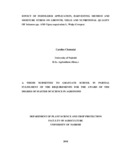| dc.description.abstract | The low productivity of the African nightshade (Solanum spp.) and cowpea (Vigna unguiculata L. Walp.) leafy vegetables in smallholder farms in Kenya is partly attributed to moisture stress, declining soil fertility and poor leaf harvesting practices. To increase the productivity and utilization of these crops requires development of suitable agronomic practices such as appropriate watering regimes, effective nutrient management, and best harvesting practices. Pot and field experiments were conducted at the University of Nairobi's Kabete field station, to determine the effects of water stress, nutrient management and leaf harvesting method on growth, yield and nutritional quality of African nightshade and cowpea. In the first objective, individual plants were grown in10 liter polythene pots containing 10 kg of soil (a mixture of sand, topsoil and manure in the ratio of 2:4:1) each and watered daily for two weeks with tap water, to maintain soil at pot capacity, until the start of the treatments. The treatments, comprising four watering regimes namely 100% pot capacity (PC), 80% PC, 60% PC and 40% PC, were laid out in a randomized complete block design (RCBD) and replicated three times. In the second objective, the fertilizer treatments comprising 200 kg/ha Di-ammonium phosphate (DAP) fertilizer, 10 t/ha farmyard manure (FYM), 10 t/ha chicken manure (CM), 100 kg/ha DAP + 5 t/ha FYM, 100 kg/ha DAP + 5 t/ha CM and no- fertilizer (control) were tested against two harvesting methods (piecemeal and wholesome harvesting) in a randomized complete block design, replicated three times. Growth and yield data collected included leaf number, leaf area, plant height, number of branches, leaf fresh weight, leaf dry weight, leaf yield, number of pods/fruits, total grain weight, seed weight and grain yield. Chlorophyll concentration was determined at weekly intervals for four weeks. Data on leaf vitamin A and C, total anti-oxidant activity and phenolic content were also collected. All data collected were subjected to analysis of variance (ANOVA) and means separated, where the F-test was significant, using the least significant difference test at p≤0.05.
Plant height, leaf area, number of branches per plant, number of leaves per plant, total grain weight, leaf yield, number of pods or fruits per plant and chlorophyll concentration, vitamin A and vitamin C significantly decreased with reduction in soil moisture levels in both cowpea and African nightshade. Reduction of moisture level from 100% pot capacity to 40% pot capacity led to decreases in chlorophyll, leaf yield, vitamin A and vitamin C by 21.1, 65.9, 78.1 and 81.6 %, respectively, in cowpea and 52.5, 85.3, 52% and 55.8%, respectively, in African nightshade. In cowpea, reduction in soil moisture levels significantly decreased 100-seed weight, and grain yield. Phenolic content and total anti-oxidant activity significantly (p≤0.05) increased with reduction in soil moisture levels in both crops. Reduction of moisture from 100% PC to 40% PC led to increases in phenolics and total antioxidant by 29.4 and 18.7%, respectively, in cowpea and 34.5 and 45%, respectively, in African nightshade. Fertilizer application significantly increased plant height, number of leaves per plant and leaf yield of cowpea and African nightshade. Compared to the no-fertilizer control, application of DAP, DAP + CM, DAP + FYM, CM and FYM increased leaf yield by 68.6, 58.3, 56.6, 52.2 and 42.6%, respectively, in cowpea and 74.9, 63.7, 60.8, 56.4 and 41.1%, respectively, in African nightshade. Fertilizer application had no significant effect on vitamin A and C, phenolics and antioxidant activity in both crops. Compared to wholesome harvesting, piecemeal harvesting significantly increased the number of leaves and leaf yield by 54.1 and 43.9%, respectively, in cowpea and 51.2 and 49.3%, respectively, in African nightshade.
Water stress reduced growth, yield and nutritional quality of cowpea and African nightshade, but increased phenolic content and total antioxidant activity in both crops. Fertilizer application increased the growth and leaf yield but had no influence on leaf vitamin A, leaf vitamin C, phenolics and antioxidant activity in both cowpea and African nightshade. Relative to wholesome harvesting, piecemeal harvesting enhanced growth and leaf yield of cowpea and African nightshade but reduced the leaf nutritional quality in both crops. | en_US |



